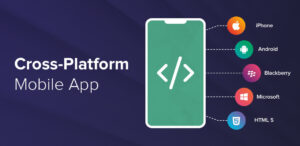Cross-stage improvement alludes to the act of making programming applications that can run on various stages or working frameworks utilizing a solitary codebase. In today’s digital landscape, where users access content and services across various devices and platforms, cross platform development has become increasingly important for businesses and developers alike.
What is cross-platform development?
Cross platform development involves writing code that can be compiled or interpreted to run on different platforms, such as iOS, Android, and web browsers, without the need for significant modifications. This approach streamlines the development process and allows developers to reach a broader audience with their applications.
Importance of cross-platform development
The proliferation of mobile devices, tablets, and other digital platforms has fragmented the market, making it challenging for developers to create separate versions of their applications for each platform. Cross-stage improvement offers a savvy arrangement by empowering engineers to compose code once and send it across different stages, saving time and assets.
Advantages of Cross-Platform Development
Cost-effectiveness
One of the primary advantages of cross platform development is its cost-effectiveness. Instead of developing separate versions of an application for each platform, developers can write code once and deploy it across multiple platforms, reducing development costs significantly.
Uniform user experience
Cross platform development allows developers to maintain a consistent user experience across different platforms. By using a single codebase, developers can ensure that the application’s features, functionality, and design elements remain consistent regardless of the device or operating system used by the end user.
Wider audience reach
By targeting multiple platforms with a single codebase, developers can reach a broader audience with their applications. This approach allows businesses to maximize their reach and engage users across different devices and operating systems, increasing the potential for user acquisition and revenue generation.
Challenges in Cross-Platform Development
Despite its many benefits, cross platform development also presents several challenges that developers need to consider.
Performance issues
One common challenge in cross platform development is performance optimization. Since cross-platform frameworks need to translate code into native instructions at runtime, they may introduce overhead and performance bottlenecks compared to native development.
Compatibility concerns
Another challenge is ensuring compatibility across different devices, screen sizes, and operating systems. Developers need to test their applications thoroughly on various platforms to identify and address compatibility issues that may arise.
Limited access to native features
Cross-platform frameworks may offer limited access to platform-specific features and APIs, which can restrict the functionality of the application. Developers need to carefully evaluate the requirements of their application and choose a framework that provides adequate support for the desired features.
Popular Cross cross-platform development Frameworks

Several cross-platform development frameworks are available to developers, each with its own set of features, benefits, and limitations.
React Native
React Native, developed by Facebook, is a popular cross-platform framework for building mobile applications using JavaScript and React. It allows developers to create native-like experiences with a single codebase, making it a preferred choice for many developers and businesses.
Xamarin
Xamarin, acquired by Microsoft, is another cross platform framework that enables developers to build native iOS, Android, and Windows applications using C# and . NET. It provides access to native APIs and platform-specific features, allowing developers to create high-performance applications with a familiar development environment.
Flutter
Shudder, created by Google, is an open-source UI tool compartment for building locally gathered applications for portable, web, and work areas from a solitary codebase. It uses the Dart programming language and offers a rich set of pre-built widgets and libraries for creating beautiful and responsive user interfaces.
Ionic
Ionic is a famous cross-stage structure for building versatile web applications utilizing web innovations like HTML, CSS, and JavaScript. It provides a library of UI components, themes, and plugins to streamline the development process and deliver engaging user experiences across platforms.
Comparison of Cross-Platform Development Frameworks
When choosing a cross-platform development framework, developers need to consider various factors such as performance, development time, and community support.
Performance
Performance is a critical factor to consider when selecting a cross platform framework. While some frameworks may offer native-like performance, others may suffer from performance overhead and limitations. Developers should benchmark and test different frameworks to determine which one best meets their performance requirements.
Development time
The time it takes to develop an application can vary depending on the chosen framework and the complexity of the project. Some frameworks may offer features such as hot reloading and code reuse, which can accelerate the development process and reduce time-to-market.
Community support
Local area support is fundamental for cross-stage systems as it guarantees progressing improvement, updates, and bug fixes. Developers should choose frameworks with active and engaged communities that provide resources, documentation, and support to help them overcome challenges and learn best practices.
Best Practices in Cross-Platform Development
To ensure the success of cross platform development projects, developers should follow best practices and guidelines.
UI/UX considerations
UI/UX design plays a crucial role in the success of an application. Developers should pay attention to platform-specific design guidelines and best practices to create intuitive and user-friendly interfaces that provide a consistent experience across different platforms.
Code optimization
Code optimization is essential for improving the performance and efficiency of cross-platform applications. Developers should follow coding standards, minimize code redundancy, and optimize resource usage to ensure smooth performance across various devices and operating systems.
Regular testing across platforms
Thorough testing is critical to identifying and addressing compatibility issues, bugs, and performance bottlenecks in cross platform applications. Developers should conduct comprehensive testing across different devices, screen sizes, and operating systems to ensure that their applications deliver a seamless experience to users.
Case Studies
Several successful applications have been developed using cross platform frameworks, demonstrating their effectiveness and versatility.
Instagram, one of the world’s most popular social media platforms, was built using React Native. The cross-platform framework allowed Instagram to deliver a consistent user experience across iOS and Android devices while streamlining the development process.
Microsoft Teams
Microsoft Teams, a leading collaboration platform, was developed using Xamarin. The cross-platform framework enabled Microsoft to create a feature-rich application with native performance and seamless integration with the Microsoft ecosystem.
Future Trends in Cross-Platform Development
As technology continues to evolve, several trends are shaping the future of cross-platform development.
Emerging technologies
Advancements in technologies such as augmented reality (AR), virtual reality (VR), and the Internet of Things (IoT) are creating new opportunities for cross-platform development. Developers can leverage these technologies to create innovative and immersive experiences that span multiple devices and platforms.
Improvements in existing frameworks
Cross-platform frameworks are continually evolving to address the needs and challenges of developers. Future updates and releases are expected to introduce enhancements in performance, scalability, and feature support, further strengthening the appeal of cross-platform development.
Conclusion
Cross-platform development offers a cost-effective and efficient solution for building applications that can run seamlessly across multiple platforms. While it presents challenges such as performance optimization and compatibility concerns, the benefits of cross-platform development outweigh the drawbacks. By following best practices, leveraging the right frameworks, and staying abreast of emerging trends, developers can create high-quality cross-platform applications that meet the needs and expectations of users.
FAQs
How truly does cross-stage advancement vary from the local turn of events?
- Cross platform development involves writing code that can run on multiple platforms using a single codebase, while native development involves writing separate codebases for each platform.
Is cross platform development suitable for all types of applications?
- Cross-stage improvement is reasonable for a great many applications, including portable applications, web applications, and work area applications. However, it may not be suitable for applications that require extensive use of platform-specific features or high-performance requirements.
What factors should be considered when choosing a cross-platform framework?
- When choosing a cross-platform framework, developers should consider factors such as performance, development time, community support, and access to native features and APIs.
Can cross-platform apps achieve the same performance as native apps?
- While cross-platform apps may not always achieve the same level of performance as native apps, advancements in cross-platform frameworks and technologies have significantly narrowed the gap in recent years.
Are there any limitations to cross-platform development?
- Cross-platform development may have limitations in terms of performance optimization, access to native features, and compatibility with certain device configurations and operating systems. Developers should carefully evaluate these limitations and choose the right framework for their project.


